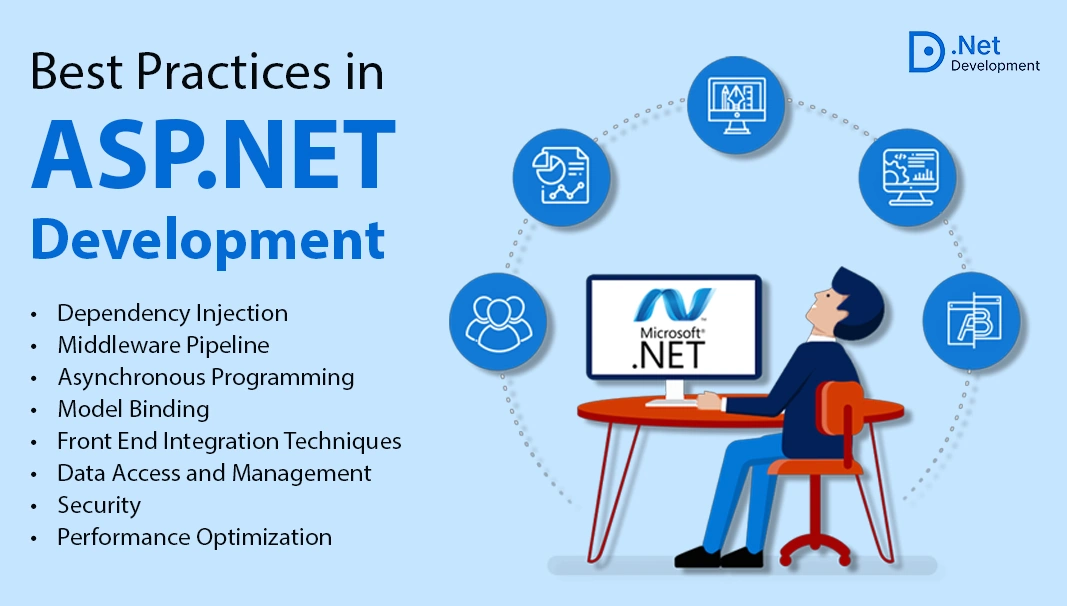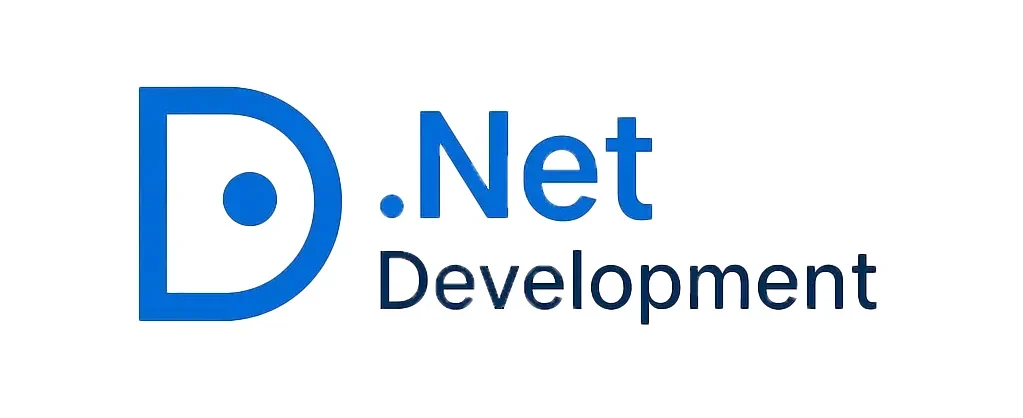ASP.NET Development Techniques

- .NET Development
- July 2, 2025
- Manish Kumawat
With various application development uses, ASP.NET allows for the creation of fully responsive web pages that are backed by solid backend logic. From working with new business ideas to modifying the outdated legacy software, it covers a wide range of development domains. This is all done using the comprehensive ASP.NET development techniques. The web applications built with the help of this framework are highly efficient and dynamic. Whether you’re an ASP.NET developer or a business owner who wants to know the depth of this framework, we are going to break down all these topics in this blog.
ASP.NET Framework
Microsoft develops this open-source application development framework. This backend technology integrates or works with frontend techniques for building a full-fledged web application. It also offers support from Razor Pages and Blazor, which helps in building interactive user interfaces.
With the support of multiple technologies such as C#, Razor Pages, Blazor, Authentication, etc., ASP.NET is a one-stop solution for a complete development requirement. It is also used to build cloud-native applications, which are highly secured with the help of a built-in security package. It also comes with MVC, a web form development model that facilitates optimized building and deployment using CI/CD techniques.
Know about ASP .NET in detailed manner by this ultimate guide
Core ASP.NET Development Techniques
ASP.NET provides various development and deployment techniques that are mostly used by developers. The techniques are mentioned below:
Web Forms
This is a very useful model. It uses component-based development where servers are used to render HTML and for event handling. The overall speed of the web page increases by extracting the HTML as much as possible. This model is very useful for beginners because of its simplicity, but it can be unsuitable for complex programming or projects.
MVC (Model-View-Controller) : ASP.NET Development Techniques
This is a widely used architecture where multiple functionalities are divided into various parts. With the help of this testing and validation becomes flexible. This can be an ideal way for building a large-scale project that requires many features and functions. It gives higher control over HTML to the developers.
Know features of ASP .NET development
ASP.NET Core
This is the most advanced version of .NET. It provides cross-platform development with integration of microservices and various APIs. It supports several development techniques like dependency injection, middleware, and integration with frontend frameworks like React or Angular.
Best Practices in ASP.NET Development

It comes with many other practices that are used to build powerful web pages that can fit with developers’ requirements. The development techniques of ASP.NET applications are very structured and full of pre-defined libraries that provide code usability and make the application lightweight.
Layered Architecture
Developers use a layered architecture where goals or concerns are separated for development. This method improves maintainability and enhances performance. In this, three layers are present. The first is Presentation Layer, where the UI logic is designed and handles to implementation clean user experience. The second layer is the Business Logic Layer (BLL), which is responsible for maintaining the rules and regulations of the application.
The last layer is the Data Access Layer (DAL), which works for managing the databases with the help of various tools like Entity Framework or ADO.NET. This structured architecture provides high usability and improves the load efficiency of the web pages.
Dependency Injection (DI)
ASP.NET Core is one of the most advanced development frameworks. It comes with the support of Dependency Injection, which provides the facility of loose coupling between components. This enhances the code modularity, which further makes the testing phase more accurate. With these, developers can use dependencies using constructors instead of initializing them in classes.
Example:
Middleware Pipeline Configuration
These components are used to handle the request and response pipelines. From managing tasks like routing, authentication, and logging, middleware is configured in Startup.cs using methods like UseRouting(), UseAuthentication(), and UseEndpoints(). These tasks are embedded in HTTP requests.
Example:
This technique enhances the security of cloud-based web applications, and routing is handled systematically.
Asynchronous Programming
This is a dynamic programming technique. It helps in writing non-blocking code using the async/await functions. This makes it easier to handle various concurrent operations at the same time without waiting for the completion of one operation.
Example:
This type of programming technique is very useful when there is a high load on the application.
Model Binding and Validation
This is a crucial aspect of ASP.NET development. It is responsible for managing user data flow and integrity. It binds or maps the incoming HTTP requests and ensures that the data flow is based on the pre-defined set of rules.
Its working starts from form data, query strings, and JSON payloads. Model binding and validation work in parallel to ensure that the data transition is smooth and secure from the user to the server and to the databases.
Example:
public class UserModel
{
[Required]
public string Username { get; set; }
[EmailAddress]
public string Email { get; set; }
}
Front-End Integration ASP.NET Developmont Techniques
With server-side development, the frontend plays a vital role. The user interface is the main point where the user will interact with the server. ASP.NET Core gets support from various frontend development techniques, which are mentioned below:
Razor Pages
Used to develop interactive and responsive user interfaces. This is used to design the frontend of an application in coordination with the backend logic. It combines the view and controller logic in a single page, which increases the speed and interactivity of the user.
Features:
- Combines view and PageModel logic in one unit
- Uses clean, file-based routing (URL maps directly to file)
- Supports model binding and server-side validation
- Reduces boilerplate compared to MVC
- Simplifies form handling and data processing
- Encourages the separation of concerns within each page
This is a plus point in ASP.NEET Core development because you can develop a full-fledged application with this single framework.
SPA Integration with Angular/React in ASP.NET Development Techniques
The ASP.NET Core smoothly integrates with Single Page Application (SPA) frameworks like React, Angular. This helps in preventing unnecessary rendering or refreshing of the web page when one component is in use. For making highly efficient user interfaces, this functionality of the ASP.NET Core is complete.
Features:
- Use ASP.NET Core Web API for the backend
- Host SPA assets using UseSpaStaticFiles()
- Enable development middleware for frontend hot reloading.
This technique is widely used for building modern, responsive, and load-efficient web pages.
Data Access and Management: ASP.NET Development Techniques

Every application contains a data flow, and it is important to manage all this data. For providing high-end security and integrity to data, ASP.NET consists of various techniques, which are:
Entity Framework Core (EF Core)
Entity Framework Core powerful ORM (Object-Relational Mapper) specially developed for the ASP.NET Core framework. With the help of mapping the classes of C#, it manages the database operations. It is like a barrier between UI and the database. It is responsible for the interaction of the user with the databases effectively.
- Code-first and database-first development approaches
- LINQ for querying data using C# syntax
- Change tracking to monitor object state and apply updates
- Automatic migrations to manage database schema changes
- Lazy and eager loading for related data
Repository Patterns in ASP.NET
In the context of proving modularity to the applications, a system of repository pattern is used. It helps in abstract data access logic easily.
Example:
public interface IProductRepository
{
Task<IEnumerable<Product>> GetAllAsync();
}
Security Techniques in ASP.NET Development Techniques
Securing the applications is one of the major concerns. ASP.NET contains various security packages and techniques that can handle several security threats to the application.
Authentication and Authorization
ASP.NET supports cookie-based, token-based, and third-party (OAuth, OpenID) authentication methods. There are some authentication methods available in ASP.NET development. One of the most common API authentication techniques is using the JWT (JSON Web Token). This is used to secure the information transition between multiple parties (Two).
Example:
services. AddAuthentication(JwtBearerDefaults.AuthenticationScheme)
.AddJwtBearer(options => {
options.TokenValidationParameters = new TokenValidationParameters {
ValidateIssuer = true,
ValidateAudience = true,
…};});
CSRF and XSS Protection
There are some web bugs or threats present, like CSRP (Cross-Site Request Forgery) and XSS (Cross-Site Scripting). For fixing them, ASP.NET has built-in security patches. For CSRP, you can use @Html.AntiForgeryToken() in forms to generate unique tokens and validate them on the server.
You can handle this with this method. If the threat is XSS, then ASP.NET automatically HTML-encodes output to prevent script injection. Avoid using Html.Raw unless the content is sanitized.
HTTPS and Secure Headers
Securing HTTPS with the help of middleware can be effective. Configure security headers like Strict-Transport-Security, X-Content-Type-Options, etc.
These practices can help in preventing the application from any threats or vulnerabilities. Try to secure the web pages because with this approach, the integrity and usability can be maintained.
Performance Optimization: ASP.NET Development Techniques
ASP.NET has many ways to optimize the overall performance of web applications. The developer can use caching to reduce server load and speed up responses. This method can help in storing the behaviour of the user and loading the pre-required data without affecting the server and the backend logic.
Using the compression technique can be useful. Gzip or Brotli compression can be enabled via middleware. You can bundle the excessive scripting and CSS files so that the loadable file will be reduced. The developer can use CDNs for common libraries and small-sized image extensions that help in increasing the UI experience. Plus, the developer can use structured databases with sequential entries and operations. This will optimize queries and enhance the transfer of data from databases.
Testing and Debugging: ASP.NET Development Techniques
Testing is one of the most important aspects of development. Only with the help of various testing phases, the quality of the application is decided, and it is ensured that the developed software is as per the client’s requirements. Some ASP.NET development techniques for testing:
Unit Testing
This testing phase ensures that each component of the developed application is working as per the expectations or not. Developers commonly use frameworks like xUnit or NUnit to write and test the application based on the individual components and dependencies.
Example:
[Test]
public void GetProductById_ReturnsCorrectProduct()
{
var mockRepo = new Mock<IProductRepository> ();
…
}
Integration Testing
As the name suggests, this testing technique ensures that the components or the web page are working as expected with each other. Using the “TestServer” and “HttpClient,” developers can test the application without hosting on a real server, and a simulation of HTTP requests helps in getting the response insight.
Know more by this guide about how to hire asp .net developer
Deployment and CI/CD Techniques
The completely developed application follows ASP.NET development techniques of deployment and CI/CD (Continuous Integration and Continuous Deployment). This is the critical step after the development. Here, the developed application will be deployed in another environment. One of the most commonly used deployment methods is Docker. It allows developers to create a lightweight and easily accessible deployment environment.
The cloud-based application developed using the ASP.NET techniques is easily deployed on cloud-native platforms like Azure. Direct integration with Azure microservices and other cloud modules, the application will run smoothly in the client’s environment. CI/CD pipelines are essential for deploying large-scale projects.
Using Docker, cloud hosting, and CI/CD pipelines creates an effective and robust ecosystem that enhances usability, integrity, and maintainability. ASP.NET contains a complete package for developing and deploying the best web applications.
Conclusion
An expert developer should be familiar with all these ASP.NET development techniques to build highly efficient web applications that deliver positive value. Support from structured architectures to an optimized deployment ecosystem this is the path toward successful software development. ASP.NET covers a wide range of categories from healthcare to manufacturing. This comprehensive framework helps developers create interactive and powerful platforms.
Frequently Asked Questions
For improving the application’s performance, developed using the ASP.NET framework, there are some methods to do this. Caching is an effective way to minimize the server load by storing the preferences and behaviour of the user. You can also modularize the application to prevent errors and increase maintenance.
Generally, ASP.NET uses Microsoft SQL database for complete data processing. But sometimes, when other technologies like ReactJS, NodeJS, used, then MongoDB can also be used.
ASP.NET is a framework that is developed by Microsoft. It is used for building software applications. ASP.NET Core is another framework, or we can say that it is the successor of the old development tool. It is used for building cloud-native applications and other applications.
Yes, ASP.NET uses dependency injection. This feature helps in loosening the coupling of the components and ensures that the development goes in a modular format. This increases the maintainability and enhances testing accuracy.
I am Manish Kumawat, co-founder of Fulminous Software, a top leading customized software design and development company with a global presence in the USA, Australia, UK, and Europe. Over the last 10+ years, I am designing and developing web applications, e-commerce online stores, and software solutions custom tailored according to business industries needs. Being an experienced entrepreneur and research professional my main vision is to enlighten business owners, and worldwide audiences to provide in-depth IT sector knowledge with latest IT trends to grow businesses online.

